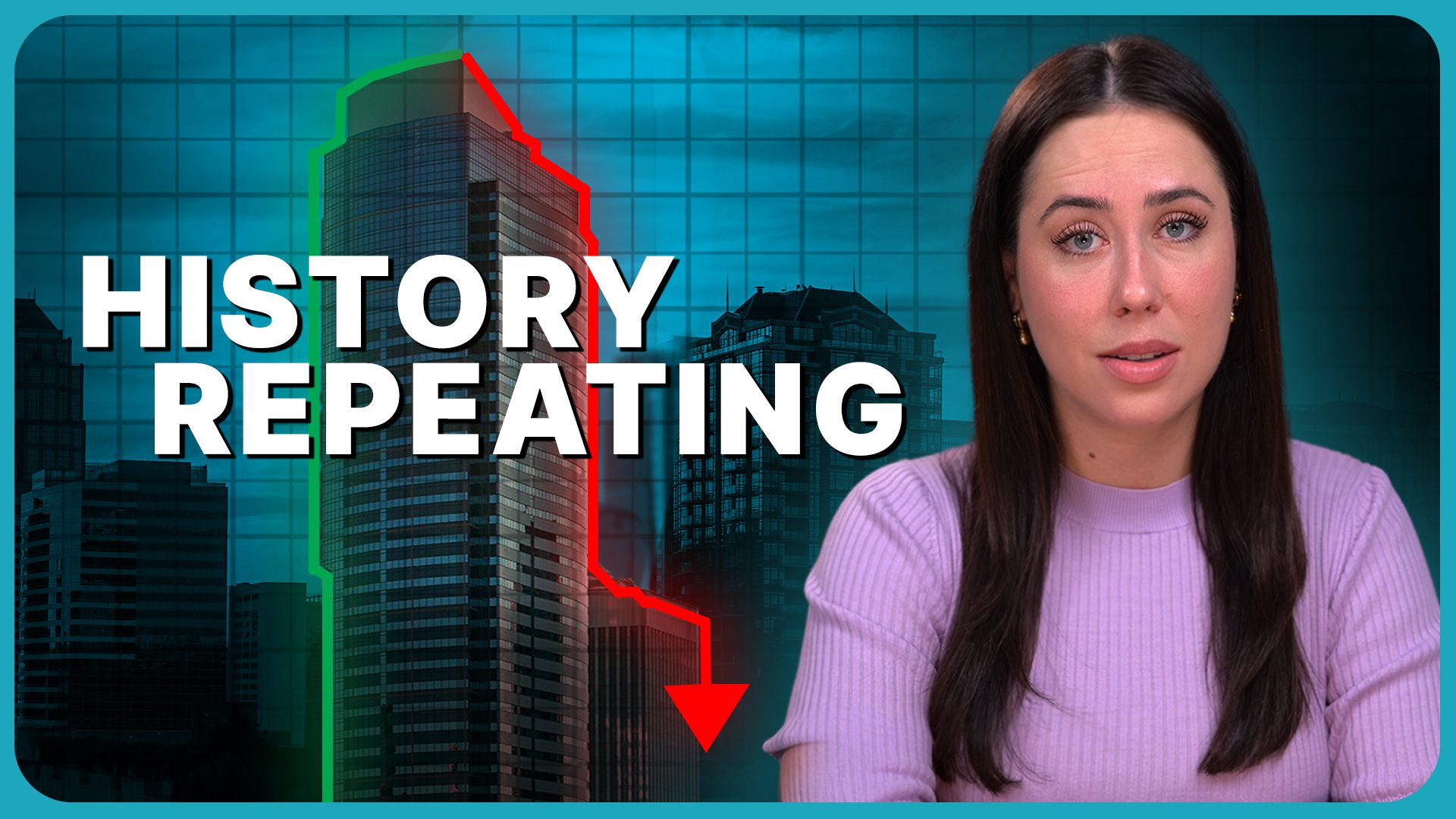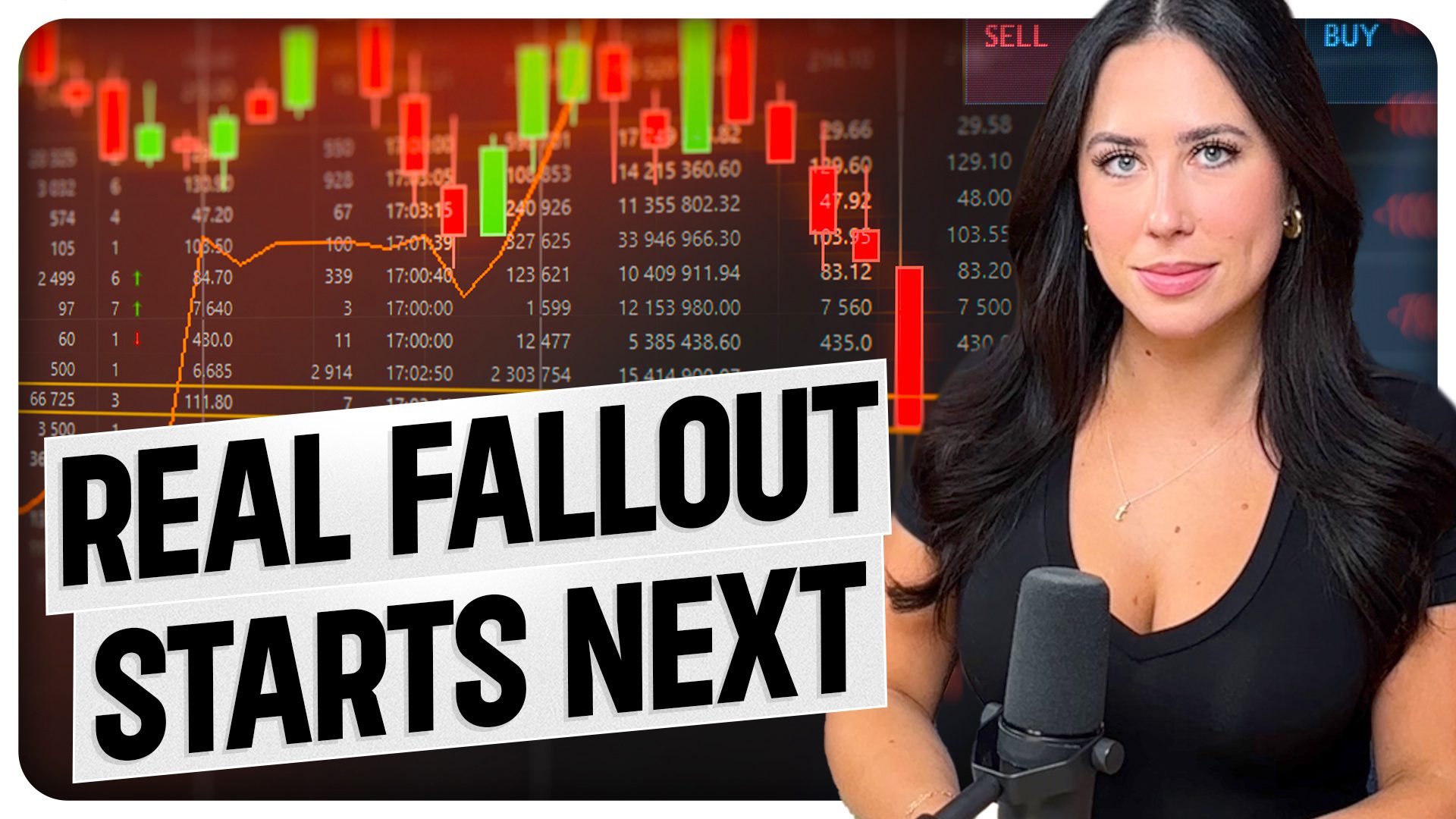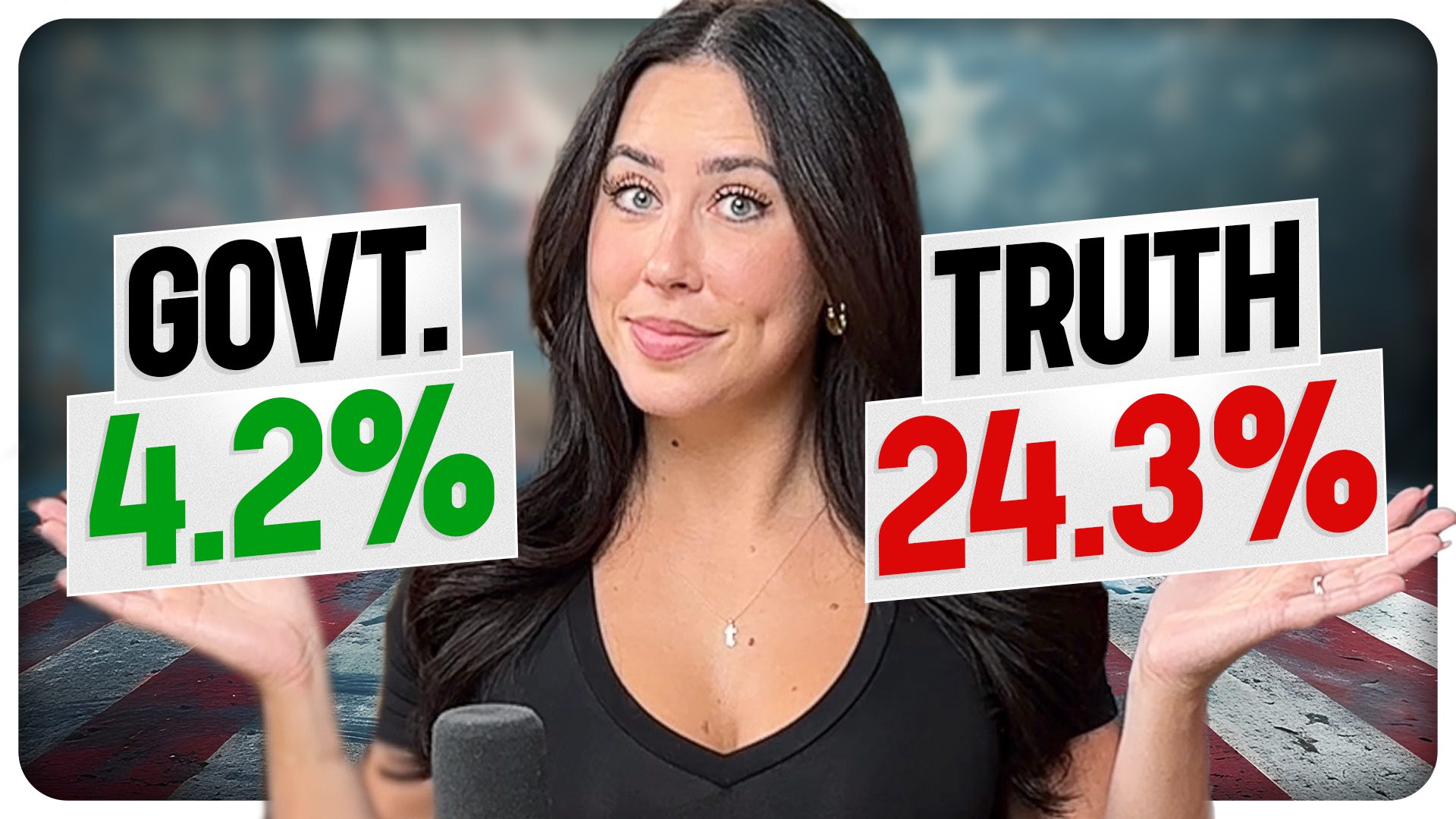WARNING: Real Estate Crisis to Create a WORSE 2008

Investors in top-rated commercial real estate bonds are facing significant losses for the first time since 2008, potentially signaling another financial crisis driven by derivative exposure. With over 2,600 banks heavily exposed to commercial real estate and $1 trillion in debt maturing by the end of 2024, the financial system is at risk of widespread defaults and economic instability. As defaults rise, the resulting liquidity crisis could lead to bank failures, credit market freezes, and long-term economic impacts, underscoring the importance of safeguarding assets beyond traditional financial systems.
TRANSCRIPT:
For the first time since the 2008 financial crisis. Investors holding top rated bonds backed by commercial real estate are facing major losses. Does this mean that another derivative based crisis, this time in commercial real estate, is headed our way?
Buyers holding the AAA portion of a $308 million note, backed by the mortgage of 1740
Broadway in Manhattan, receive less than 75% of their original investment after the loan was sold at a significant loss. All lower tier creditors were completely wiped out.
This confirms what many of us have already suspected that a severe commercial real estate crisis, caused by low vacancy rates and high interest rates is imminent. But just how large could this crisis get, and how will it impact you? And while the current crisis is brewing isn’t an exact repeat of 2008, there are still many parallels.
We’re not talking about just a handful of office buildings, but rather a very popular type of mortgage backed security that represents trillions of dollars on banks balance sheets. And you may be saying to yourself right now, well, I’m not invested in commercial real estate. Why does it matter to me if these loans are defaulted on and sold at a loss?
Most likely an asset manager or some kind of property developer will come along and scoop them all up.
And you would be partially right. That is most likely what will happen. But the losses and the pain from these defaults in these loans being sold at a loss are absolutely going to waterfall down to you and I. And I’ll explain why.
In 2008, when the fed started raising rates, mortgage holders could no longer make their payments.
As rates rose, demand fell and so did the home prices, leaving the mortgage holders with no option but to default with commercial real estate today we’re in the same situation.
Higher rates means less demand and values are lower. The only reason that we haven’t seen the mass defaults that we saw in 2008 is because this time around, banks are giving more time to mortgage holders so that they can avoid those losses. More defaults means more losses for the banks. As it stands today, banks balance sheets are severely inflated because they’re not representing the true nature of the value of these properties, or the losses that these loans are inevitably going to be suffering.
And this inflated balance sheet issue has been an ongoing problem for banks, as they are already under tremendous stress from significant unrealized losses from their Treasury bonds thanks to higher interest rates, which means that banks today are completely ill equipped to absorb any additional losses in the form of commercial real estate defaults. So how big is the risk?
Well, in the aftermath of 2008, bank regulators started tracking the ratio of the total amount of commercial real estate loans compared to the total regulatory capital available to banks. So how many loans do they have versus how much capital is available? Once this ratio would hit 3 to 1, that’s when a bank was considered at risk.
As of the end of last year, there are over 1,700 banks across America that have a 3 to 1 ratio of exposure in commercial real estate, and that’s being generous. If we look at the real market value of these banks capital holdings and not what’s on their balance sheet, that number of banks jumps from 1,700 to over 2,600 banks with a 3 to 1 exposure just in commercial real estate. These mortgages are in jeopardy. This year, by the end of 2024.
There is about $1 trillion worth of commercial real estate debt that is set to mature, which means that many of these loan holders will be forced to default. If this happens, we could expect to see a freeze in credit markets, higher unemployment and economic crisis that could impact you for decades to come. Not to mention bank failures. In fact, if even a small percentage of these loans are defaulted on, we could see many banks rendered insolvent almost overnight.
The amount of debt right now that’s at risk of default is significantly more than the banks available capital.
And before you say, well, that’s what the Federal Deposit Insurance Corporation is for the FDIC, they’ll just step in and solve everything. It’s important to remember that the FDIC insurance fund is sitting at $121 billion dollars. To put that in context. That’s only half, .5% of the total banking systems assets, aka they don’t have nearly enough to cover significant losses.
Just last week, we helped a client who was concerned about all of these unrealized losses and what it would mean for the safety of his deposits at his bank. And he asked, even if my bank made it through, if all of these losses happened and there was a bailout, then what? Inflation continues to rise. My dollar’s worth even less, which is why I’ve been telling my friends and family forever that it’s important not to put all of your eggs in one basket, not to have all of your assets dollar denominated, because ultimately it’s important to have things protected outside of the system, which is why we do what we do.
Helping people with physical, tangible silver and gold. Because you don’t want a repeat of 2008 where you’re saying, I wish I had done this sooner. Especially as the uptick in defaults could be here sooner rather than later. Just last week, Moody’s, one of the big three credit rating agencies, disclosed that the number of office loan delinquencies packaged in these common securities reached 6.4% last month.
And beyond that, almost 31% of all office loans are in trouble. That’s up 16% from just last year. There are combination of reasons why this is occurring, but the biggest one is interest rates, which has resulted in lower cash flow and higher investment return requirements. And the way things are going. I don’t see these interest rates coming down anytime soon.
And just like 2008, it’s not just the defaults on these loans that are the real problem
of course. Mass mortgage defaults in 2008 were painful, but it was the exposure from the derivatives that caused the global economic meltdown. Warren Buffett has referred to derivatives as financial weapons of mass destruction. But what exactly are they? And just how big is the risk?
Since we’re talking about property and mortgages. Let’s go through the four steps of how a mortgage backed security is created. And as a quick side note. Mortgage backed securities are considered derivatives. As derivatives derive their value from an underlying asset. In this case, the mortgage loans. More on that in a second.
Historically, mortgages were put into a big pool, a trust, let’s say $1 billion worth of mortgages. All the mortgages in your city were put into one trust. Investors could then have a fractional interest in that pool of mortgages, and they would receive cash flow as the mortgages were repaid.
No problem there because the idea was if you have a large enough pool of mortgages, the risk would always be low to investors. But then collateralized debt obligations, CDOs came along, which is where they would take the pool of mortgages and slice it up into slices or tranches. And it worked like this.
Step one, the bank lends money to a homeowner. Or in commercial real estate, an asset manager. Step two, the bank takes the mortgage that they just created and sells it to another company like Fannie Mae. That way, the bank then has more money to go out and make more loans.
Step three, Fannie Mae takes that mortgage and packages up with all the other mortgages in that pool that I was talking about. This creates a mortgage backed security, and they then sell that on the secondary market.
But step four is when the problem begins, a hedge fund manager or an investment bank takes up mortgage backed security, slices it up and starts selling off just the slices or the tranches of it.
Now, each one of those slices has a rating associated with it that’s supposed to determine how safe it is. The credit rating system runs from AAA, the most reliable, the least likely to default all the way down to the most likely to default in the least reliable.
As you can imagine, with AAA being the safest, the yield on a AAA CDO was actually much less than a BBB CDO, because the risk for those investing in a subprime or lower rated tier was higher.
So they would make more money if they invested in a subprime CDO.
Now, somewhere along the line in 2005, it was realized that if you kept pulling apart all of these slices and re-bundling just the slices back together, they were rated much higher than they should have been.
You could have a bundle of all BBB, and somehow two thirds of it would be rated
AAA, which is why people started then selling off more and more and re-bundling them back together and repeating this process again and again and again until it reached a point where there were all of these bundles out there, and no one even could tell what was in them.
And if you’re confused, you’re not alone. This is why so many people were blindsided by 2008, because no one had a clue about how big the exposure was, because it had all gotten so convoluted along the way.
But it’s happening again in the aftermath of the 2008 financial crisis. People moved away from these CDOs. Obviously, they were deemed far too risky and demand plummeted.
But in 2011, something new was created a successor to the CDO called a Collateralized Loan Obligation, a CLO. The only difference being that CLO’s are backed by corporate credit and leveraged loans, and have slightly more protections in place. But the basic vehicle is the same. Different entities hold billions of dollars of commercial real estate loans, and investors buy slices of these vehicles.
And everything was fine until the pandemic hit, when suddenly there was a huge demand for work from home, and real estate developers were keen to take out short rate loans in order to buy apartment buildings to renovate and sell for a profit.
Issuance of CLO’s jumped 125% in 2021 alone, with most of the collateral inside of these obligations tied to multifamily property. Part of the way that these commercial real estate CLO’s are set up is that the idea is that the developers would be able to sell the property before the loan matured.
But with today’s landscape, there’s no way that the majority of these can be sold for anywhere near what they were purchased for, let alone with these developers invested in them. Up until this week, there had never been a AAA rated CLO tranche that had defaulted. But we can’t say that anymore.
Listen, it’s no secret that the commercial real estate sector is struggling. It’s what almost brought down New York Community Bancorp earlier this year.
Treasury Secretary and Federal Reserve Chair Jerome Powell have both issued warnings about the commercial real estate sector. And we see it with our own eyes if we look out the window on a drive. But the $20 trillion commercial real estate market is only the tip of the iceberg.
The real concern here, the real question is what happens when these defaults start to happen in rapid succession in high numbers? And these banks don’t have enough liquidity or capital when these unrealized losses that are sitting on their bank sheets become realized.
What happens then?
What happens to all of the other derivative exposure the banks are currently sitting on?
The value of derivatives held by J.P. Morgan Chase, Citibank and Goldman Sachs alone is $200 trillion.
And while it’s impossible to know just how much is out there in total existence, it is estimated that there is over $1 quadrillion worth of derivative exposure in the world right now.
It’s difficult to convey just how big that number is, because we don’t even have a good scope of reference.
The world itself is only 14 billion years old, and the world total GDP is about 100 trillion. We’re talking about $1 quadrillion worth of derivative exposure.
And while I will say that banks aren’t always the principal holders on all these derivatives, often instead acting as intermediaries, it does still raise significant concerns about market stability, especially when there’s little to no regulation.
And the off balance sheet growth continues to happen at a rapid pace, the same way that it did in 2008. When it reaches a point where things are so convoluted and built on top of each other that we don’t even know what we’re looking at anymore, or the exact scope of risk that we’re facing.
No one has a crystal ball. No one knows exactly what’s coming next.
But what we can do is learn from the past and look at the current data that we have available to us now, to understand what risks are ahead and how we can protect ourselves.
This wall of debt maturity is coming this year.
What happens when it hits? Because it’s not too late yet.
But you don’t want to be in a position where you’re looking back thinking, I wish I had done something sooner. And even if you are not ready right now to protect yourself outside of the system, or you’re not sure how to start with gold and silver, you can still take that first step to protecting yourself by talking to a member of our team.
And if you’re not already, be sure to subscribe, because I’m sure that we’re going to be covering this a lot more as the year continues.
What are your thoughts on all of this? What do you think is going to happen next?
Let me know your thoughts in the comments below. I love reading your comments and questions.
I’m Taylor Kenney with ITM Trading your trusted source for all things gold, silver and lifelong wealth protection. Until next time.
SOURCES:
https://www.bloomberg.com/news/articles/2024-05-23/cmbs-buyers-suffer-first-loss-on-aaa-debt-since-financial-crisis
https://www.wsj.com/finance/banking/banks-are-extending-office-loans-are-they-also-pretending-f62ddd80
https://www.fdic.gov/sites/default/files/2024-03/fil23064a.pdf
https://www.wsj.com/real-estate/commercial/the-bill-is-coming-due-on-a-record-amount-of-commercial-real-estate-debt-451ec8cb
https://www.marketwatch.com/story/office-loan-delinquencies-jump-to-nearly-six-year-high-says-moody-e70d8cf3
https://www.bloomberg.com/news/articles/2024-02-26/goldman-morgan-stanley-are-backstopping-riskiest-slices-of-clos
https://www.bloomberg.com/news/articles/2023-12-07/why-multifamily-is-the-next-stress-point-in-commercial-real-estate
https://www.bloomberg.com/news/articles/2024-05-01/jpmorgan-says-commercial-real-estate-clo-loan-buyouts-are-set-to-reach-a-record
https://www.marketwatch.com/story/bulletproof-to-bust-top-aaa-bonds-tarnished-by-a-blackstone-office-deals-blow-up-43e8ed96
https://www.marketwatch.com/story/bulletproof-to-bust-top-aaa-bonds-tarnished-by-a-blackstone-office-deals-blow-up-43e8ed96
https://finance.yahoo.com/news/203-trillion-derivatives-held-goldman-230016059.html
https://www.businessinsider.com/9-banks-combine-for-over-200-trillion-derivatives-exposure-2012-4
https://www.themiddlemarket.com/news-analysis/huge-debt-maturity-wall-looms-for-commercial-real-estate-sector














